Halo (religious iconography): Difference between revisions
m Reverting possible vandalism by 168.184.250.81 to version by Johnbod. False positive? report it. Thanks, User:ClueBot. (240801) (Bot) |
I said how much Master Cheif pwns. |
||
| Line 2: | Line 2: | ||
[[Image:Masaccio chapelle Brancacci.png|thumb|right|320px|[[Jesus]] and the [[Twelve Apostles]] depicted with "Floating" disk haloes in perspective (detail from ''[[The Tribute Money]]'', illustrating {{bibleverse||Matthew|17:24-27|KJV}}, by [[Masaccio]], [[1424]], [[Brancacci Chapel]]).]] |
[[Image:Masaccio chapelle Brancacci.png|thumb|right|320px|[[Jesus]] and the [[Twelve Apostles]] depicted with "Floating" disk haloes in perspective (detail from ''[[The Tribute Money]]'', illustrating {{bibleverse||Matthew|17:24-27|KJV}}, by [[Masaccio]], [[1424]], [[Brancacci Chapel]]).]] |
||
MASTER CHIEF IS THE SHIT!! |
|||
A '''halo''' ({{lang-el|ἅλως}}; also known as a '''nimbus''', '''[[aureole]]''', '''glory''', or '''gloriole''') is a ring of light that surrounds a person in art. They are often used in religious works to depict holy or sacred figures, and have at various periods also been used in images of rulers or heroes. In, among other religions, [[Hellenistic]] Greek, [[Ancient Rome|Roman]], [[Buddhism|Buddhist]] and [[Christianity|Christian]] sacred art, sacred persons may be depicted with a halo in the form of a golden, yellow or white circular glow around the head, or around the whole body, which is often called a [[mandorla]]. |
|||
==Before the time of Christ== |
==Before the time of Christ== |
||
Revision as of 19:52, 26 February 2008
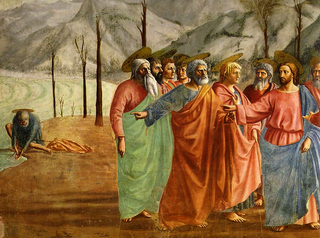
MASTER CHIEF IS THE SHIT!!
Before the time of Christ
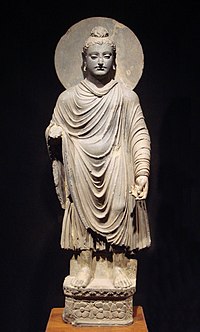
Round "solar discs" above the head are seen in depictions of many deities of Ancient Egypt, including Ra and Hathor, and symbols resembling later halos, such as the sun cross, are found in many ancient religions, especially in connection with sun worship.
Homer describes a more-than-natural light around the heads of heroes in battle,[1] and in Aristophanes' Birds the founder of Cloud-Cuckoo-Land is extravagantly said to outshine stars and sun.[2] Depictions of Perseus in the act of slaying Medusa, with lines radiating from his head, appear on a white-ground toiletry box in the Louvre and on a slightly later red-figured vase in the style of Polygnotos, ca. 450-30 BC, in the Metropolitan Museum of Art.[3] On painted wares from south Italy radiant lines or simple haloes appear on a range of mythic figures: Lyssa, a personification of madness; a sphinx, a sea demon, Thetis, the sea-nymph who was mother to Achilles,[4] The Colossus of Rhodes, was a statue of the sun-god Helios and had his usual radiate crown (copied by the Statue of Liberty). Hellenistic rulers are often shown wearing radiate crowns that seem clearly to imitate this effect.[7]
A more prosaic influence that has been cited by some historians is the Greek practice of placing circular metal discs above the head of statues to protect them from birds and their droppings, thus anticipating the "perspectival" halo by over a millenium.
In Asian art
The halo and the aureole have been widely used in Indian art, particularly in Buddhist iconography[5] where it has appeared since at least the 1st century AD; the Kushan Bimaran casket in the British Museum is variously dated between 30BC and 60AD. The rulers of the Kushan Empire were perhaps the earliest to give themselves halos on their coins, and the nimbus in art may have originated in Central Asia and spread both east and west.[6] In Chinese and Japanese Buddhist art the halo has also been used since the earliest periods in depicting the image of Amida Buddha and others. Tibetan Buddhism uses halos and aureoles of many types, drawing from both Indian and Chinese traditions, extensively in statues and Thangka paintings of Buddhist saints such as Milarepa and Padmasambhava and deities. Different coloured halos have specific meanings: orange for monks, green for the Buddha and other more elevated beings,[7] and commonly figures have both a halo for the head, and another circular one for the body, the two often intersecting somewhere around the head or neck. Thin lines of gold often radiate outwards or inwards from the rim of the halo, and sometimes a whole halo is made up of these.[8] Elaborate halos and especially aureoles also appear in Hindu sculpture, where they tend to develop into architectural frames in which the original idea can be hard to recognise. Theravada Buddhism and Jainism did not use the halo for many centuries, but later adopted it, though less thoroughly than other religious groups.

In Asian art the nimbus is often imagined as consisting not just of light, but of flames. This type seems to first appear in Chinese bronzes of which the earliest surviving examples date from before 450.[9]The depiction of the flames may be very formalized, as in the regular little flames on the ring aureole surrounding many Chola bronzes and other classic Hindu sculptures of divinities, or very prominent, as with the more realistic flames, and sometimes smoke, shown rising to a peak behind many Tibetan Buddhist depictions of the "wrathful aspect" of divinities, and also in Persian miniatures of the classic period. This type is also very rarely found, and on a smaller scale, in medieval Christian art.[10] Sometimes a thin line of flames rise up from the edges of a circular halo in Buddhist examples,[11]. In Tibetan paintings the flames are often shown as blown by a wind, usually from left to right.[12]
Later, plainer halos appear in portraits of Mughal and subsequently Rajput rulers,[13] and are also found in Islamic art from various places and periods, especially in Persian miniatures and Moghul and Ottoman art influenced by them. The Ottomans avoided using them for the sultans, despite their title as Caliph, and they are only seen on Chinese emperors if they are posing as Buddhist religious figures, as some felt entitled to do.[14] The art of Sikhism also uses them, as did some Sikh rulers.
Gallery - Egypt and Asia
-
Ra with solar disc, before 1235 BC
-
Northern Wei Buddhist bronze, 524, with two-ringed halo within a flaming mandorla
-
Jain figure, 11th century]]
-
The Mughal emperor Jahangir often had himself depicted with a halo of unprecedented size. ca. 1620
-
A multi-limbed Tibetan deity surrounded by an aureole of fire and smoke, 19th century.
-
A range of Tibetan aureoles and halos in a thangka.
In Roman art
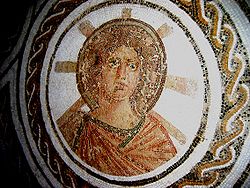
The halo represents an aura or glow of sanctity which was conventionally drawn encircling the head. It first appeared in the culture of Hellenistic Greece and Rome, possibly related to the Zoroastrian hvarena - "glory" or "divine lustre" - which marked the Persian kings, and may have been imported with Mithraism. Though Roman paintings have largely disappeared, save some fresco decorations, the haloed figure remains fresh in Roman mosaics. In a second century AD Roman floor mosaic preserved at Bardo, Tunisia,[16] a haloed Poseidon appears in his chariot drawn by hippocamps. Significantly, the triton and nereid who accompany the sea-god are not haloed.
In a late second century AD floor mosaic from Thysdrus, (El Djem, (illustration) Apollo Helios is identified by his effulgent halo. Another haloed Apollo in mosaic, from Hadrumentum, is in the museum at Sousse.[17] The conventions of this representation, head tilted, lips slightly parted, large-eyed, curling hair cut in locks grazing the neck, were developed in the third century BC to depict Alexander the Great (Bieber 1964; Yalouris 1980). Some time after this mosaic was executed, the Emperor began to be depicted with a halo,[18] which was not abandoned when they became Christian; initially Christ only had one when shown on a throne as Christ in Majesty[19].
In Christian art
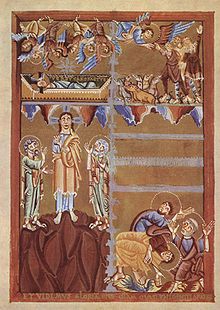
The halo was incorporated into Christian art sometime in the fourth century with the earliest iconic images of Christ, initially the only figure shown with one (together with his symbol, the Lamb of God). Initially the halo was regarded by many as a representation of the Logos of Christ, his divine nature, and therefore in very early (before 500) depictions of Christ before his Baptism by John he tends not to be shown with a halo, it being a matter of debate whether his Logos was innate from birth (the Orthodox view), or acquired at Baptism (the Nestorian view). At this period he is also shown as a child or youth, though this may be a hieratic rather than age-related representation [20]
A cross within, or extending beyond, a halo is used to represent the persons of the Holy Trinity, especially Jesus, and especially in medieval art. In Byzantine and Orthodox images, inside each of the bars of the cross in Christ's halo is one of the Greek letters ώ Ό Ν making up I AM—literally, "the Existing One" — indicating the divinity of Jesus. At least in later Orthodox images, each bar of this cross is composed of three lines, symbolising the dogmas of the Trinity, the oneness of God and the two natures of Christ. In mosaics in Santa Maria Maggiore (432-40) the juvenile Christ has a four-armed cross either on top of his head in the radius of the nimbus, or placed above the radius, but this is unusual. In the same mosaics the accompanying angels have haloes (as, in a continuation of the Imperial tradition, does King Herod), but not Mary and Joseph. Occasionally other figures have crossed haloes, such as the seven doves representing the Seven gifts of the Holy Spirit in the 11th century Codex Vyssegradensis Tree of Jesse (where Jesse and Isaiah also have plain haloes, as do the Ancestors of Christ in other miniatures).[21]
Later, triangular halos are sometimes given to God the Father to represent the Trinity.[22] When he is represented by a hand emerging from a cloud, this may be given a halo.
Plain round halos are typically used to signify saints, the Virgin Mary, Old Testament prophets, angels, symbols of the Four Evangelists, and some other figures. Byzantine emperors and empresses were often shown with them in compositions including saints or Christ, however the haloes were outlined only. This was copied by Ottonian and later Russian rulers. Old Testament figures become less likely to have halos in the West as the Middle Ages go on.[23]

Beatified figures, not yet canonised as saints, are sometimes shown in medieval Italian art with linear rays radiating out from the head, but no circular edge of the nimbus defined; later this became a less obtrusive form of halo that could be used for all figures.[24] Mary has, especially from the Baroque period onwards, a special form of halo in a circle of stars, derived from her identification as the Woman of the Apocalypse.
Square haloes were sometimes used for the living in the first millennium in Italy;[25] Pope Gregory the Great had himself depicted with one, according to the ninth-century writer of his vita, John, deacon of Rome.[26] Personifications of the Virtues are sometimes given hexagonal halos.[27]
The whole-body image of radiance is sometimes called the 'aureole' or glory; it is shown radiating from all round the body, most often of Christ or Mary, occasionally of saints (especially those reported to have been seen surrounded by one). Such an aueola is often a mandorla ("almond-shaped" vesica piscis), especially around Christ in Majesty, who may well have a halo as well. In depictions of the Transfiguration a more complicated shape is often seen, especially in the Eastern Orthodox tradition, as in the famous 15th century icon in the Tretyakov Gallery in Moscow.[28]
Where gold is used as a background in miniatures, mosaics and panel paintings, the halo is often formed by inscribing lines in the gold leaf, and may be decorated in patterns (diapering) within the outer radius, and thus becomes much less prominent. The gold leaf inside the halo may also be burnished in a circular manner, so as to produce the effect of light radiating out from the subject's head. In the early centuries of its use, the Christian halo may be in most colours (though black is reserved for Judas, Satan and other evil figures) or multicoloured; later gold becomes standard, and if the entire background is not gold leaf, the halo itself usually will be.[29]
Decline of the halo

With increasing realism in painting, the halo came to be a problem for artists. So long as they continued to use the old compositional formulae which had been worked out to accommodate haloes, the problems were manageable, but as Western artists sought more flexibility in composition, this ceased to be the case. In free-standing medieval sculpture, the halo was already shown as a flat disk above or behind the head. When perspective came to be considered essential, painters also changed the halo from an aura surrounding the head, always depicted as though seen full-on, to a flat golden disk or ring that appeared in perspective, floating above the heads of the saints, or vertically behind, sometimes transparent. This can be seen first in Giotto, who still gives Christ the cruciform halo which began to be phased out by his successors.
In in the early 15th century Jan van Eyck and Robert Campin largely abandoned their use, although some other Early Netherlandish artists continued to use them.[30] In Italy at around the same time, Pisanello used them if they did not clash with one of the enormous hats he liked to paint. Generally they lasted longer in Italy, although often reduced to a thin gold band depicting the outer edge of the nimbus, usual for example in Giovanni Bellini. Christ began to be shown with a plain halo.

Fra Angelico, himself a monk, was a conservative as far as haloes are concerned, and some of his paintings demonstrate the problems well, as in several of his more crowded compositions, where they are shown as solid gold disks on the same plane as the picture surface, it becomes difficult to prevent them obstructing other figures.
In the High Renaissance, even most Italian painters dispensed with haloes altogether, but in the Mannerist and Baroque periods, figures were placed where natural light sources would highlight their heads, or instead more discreet quasi-naturalistic flickering or glowing light was shown around the head of Christ and other figures (perhaps pioneered by Titian in his late period). Rembrandt's etchings, for example, show a variety of solutions of all of these types, as well as a majority with no halo effect at all.
The halo was rarely used for figures from classical mythology in the Renaissance, although they are sometimes seen, especially in the classical radiant form, in Mannerist and Baroque art.
By the 19th century haloes have become unusual in Western mainstream art, although retained in iconic and popular images, and sometimes as a medievalising effect. When John Everett Millais gives his otherwise realist Saint Stephen of 1895 a ring halo, it seems rather surprising.
Folk beliefs
In popular piety, this practice has led to the literal belief that saints have visible halos around their heads, rather than it be understood as a metaphorical representation. Some faithful believe the halo to be equivalent to the aura of some Eastern religions, and as with the latter, believe that halos are visible to those with perception (see New Age). Of the many stories about saints, some reports claimed that a saint was literally glowing.
Spiritual Significance in Christianity
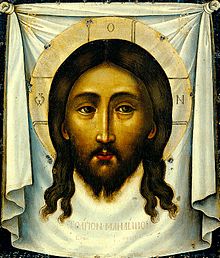
The early Church Fathers expended much rhetorical energy on conceptions of God as a source of light; among other things this was because "in the controversies in the fourth century over the consubstantiality of the Father and the Son, the relation of the ray to the source was the most cogent example of emanation and of distinct forms with a common substance" - key concepts in the theological thought of the time. [31]
In less intellectual interpretations of the haloes of saints, some see the halo as symbolizing the saint's consciousness as 'radiating' beyond the physical body, and that it serves as a pictorial reminder to the saint's devotees of the saint's transcendence of the physical body[citation needed].
A more Catholic interpretation, less dualistic in its assumptions, is that the halo represents the light of divine grace suffusing the soul, which is perfectly united and in harmony with the physical body.
In the theology of the Eastern Orthodox Church, an icon is a "window into heaven" through which Christ and the Saints in heaven can be seen and communicated with. The gold background of the icon indicates that what is depicted is in heaven. The halo is a symbol of the Uncreated Light (Greek: Ἄκτιστον Φῶς) or grace of God shinging forth through the icon. Pseudo-Dionysius the Areopagite in his Celestial Hierarcies speaks of the angels and saints being illuminated by the grace of God, and in turn illumining others.
Gallery - Christian art
-
The Emperor Justinian (and the Empress Theodora) are haloed in mosaics at the Basilica of San Vitale, Ravenna, 548. See here for earlier and here for later examples.
-
Tetraevangelia of Tsar Ivan Alexander of Bulgaria, c. 1350; the whole royal family have haloes.
-
Giotto Cappella degli Scrovegni, 1305, with flat perspectival haloes; the view from behind causes difficulties, and John's halo has to be reduced in size.
-
Netherlandish, before 1430. A religious scene where objects in a realistic domestic setting contain symbolism. A wicker firescreen serves as a halo.
-
Fra Angelico 1450, Mary's halo is in perspective, Joseph's is not. Jesus still has a cruciform halo.
-
The Lutheran Hans Schäufelein shows only Christ with a halo in this Last Supper (painted in 1515).
-
In Simon Ushakov's icon of the The Last Supper (1685) eleven of the twelve apostles have halos: only Judas Iscariot does not.
-
Salvator Mundi, 1570, by Titian. From the late Renaissance a more "naturalistic" form of halo was often preferred.
-
William Blake uses the hats of the two girls to suggest haloes in the frontispiece to Mary Wollstonecraft's "Original Stories from Real Life", 1791.
-
Julius Schnorr von Carolsfeld was a member of the Nazarene movement that looked back to medieval art. However, in The Three Marys at the Tomb, 1835, only the angel has a halo.
Origins and usage of the different terms
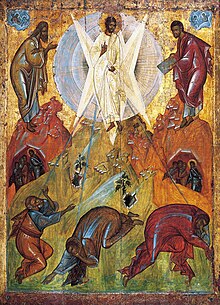
The distinction between the alternative terms in English is rather unclear. The oldest term in English is "glory", the only one available in the Middle Ages, but now largely obselete. It came from the French "gloire" which has much the same range of meanings as "glory". "Gloriole" does not appear in this sense until 1844, being a modern invention, as a diminutive, in French also. "Halo" is first found in English in this sense in 1646 (nearly a century after the optical or astronomical sense). Both "halos" and "haloes" may be used as plural forms, and halo may be used as a verb.[32] Halo comes originally from the Greek for "threshing-floor" - a circular, slightly sloping area kept very clean, around which slaves or oxen walked to thresh the grain. In Greek this came to mean the divine bright disk.
Nimbus means a cloud in Latin, and is found as a divine cloud in 1616, whereas as "a bright or golden disk surrounding the head" it does not appear until 1727. The plural "nimbi" is correct but "rare"; "nimbuses" is not in the OED but sometimes used. "Nimb" is an obselete form of the noun, but not a verb, except that the obselete "nimbated", like the commoner "nimbate", means "furnished with a nimbus". It is sometimes preferred by art-historians, as sounding more technical than halo.[33]
"Aureole", from the Latin for "golden", has been used in English as a term for a gold crown, especially that traditionally considered the reward of martyrs, since the Middle Ages (OED 1220). But the first use recorded as a term for a halo is in 1848, very shortly after which matters were greatly complicated by the publication in 1851 of the English translation of Adolphe Napoléon Didron's important Christian Iconography: Or, The History of Christian Art in the Middle Ages, which by what the OED calls a "strange blunder" derived the word from the Latin "aura" as a diminutive, and also defined it as meaning a halo or glory covering the whole body, whilst saying that "nimbus" referred only to a halo round the head. This, according to the OED, reversed the historical usage of both words, but whilst Didron's diktat was "not accepted in France", the OED noted it had already been picked up by several English dictionaries, and influenced usage in English, which still seems to be the case, as the word is mostly found describing whole-body halos, and seems to have also influenced "gloriole" in the same direction.[34]
The only English term that unequivocably means a full-body halo, and cannot be used for a circular disk round the head is "Mandorla", first occurring in 1883. However this is derived from the Italian for "almond" and, at least in describing Christian art, is usually reserved for the vesica pisces shape. In discussing Asian art, it is used more widely.[35]. Otherwise there could be said to be an excess of words that could refer to either a head-disk or a full-body halo, and no word that clearly denotes a full-body halo that is not vesica pisces shaped. "Halo" by itself, according to recent dictionaries,[36] means only a circle around the head, although Rhie and Thurman use the word also for circular full-body aureoles.[37]
See also
Notes
- ^ Iliad v.4ff, xviii.203ff.
- ^ A hyperbole that would raise a laugh in fifth-century Athens became a poetic commonplace in the panegyrics of the late Roman Empire.
- ^ Marjorie J. Milne, "Perseus and Medusa on an Attic Vase" The Metropolitan Museum of Art Bulletin New Series, 4.5 (January 1946, pp. 126-130) 126.p.)
- ^ L. Stephani, Nimbus und Strahlenkranz in den Werken der Alten Kunst" in Mémoires de l'Académie des Sciences de Saint-Petersbourg, series vi, vol. vol ix, noted in Milne 1946:130.
- ^ Metropolitan Museum of Art: Art of South Asia, [1]
- ^ Metropolitan Museum of Art: Art of South Asia, [2]
- ^ including the Qianlong_Emperor - see note below. Rhie, Marylin and Thurman, Robert (eds):Wisdom And Compassion: The Sacred Art of Tibet, p. 99, & passim, 2000, 1991, ISBN: 0-8109-2526-5
- ^ Rhie and Thurman, pp 77, 176, 197 etc.
- ^ No doubt, as later, the same motif appeared in paintings, but none survive from this early. L Sickman & A Soper, "The Art and Architecture of China", Pelican History of Art, 3rd ed 1971, pp 86-7, Penguin (now Yale History of Art), LOC 70-125675
- ^ See Didron
- ^ Often in paintings from the Dunhuang caves, see Anne Farrer (ed), "Caves of the Thousand Buddhas" , 1990, British Museum publications, nos 42, 53, 54 etc, ISBN 0 7141 1447 2
- ^ Rhie and Thurman, p.161
- ^ Metropolitan Museum of Art: Art of South Asia, [3]
- ^ Such as the Qianlong Emperor [4], and his father.
- ^ The ring of fire is ascribed other meanings in many accounts of the iconography of the Nataraja, but many other types of statue have similar aureoles, and their origin as such is clear.
- ^ Illustrated.
- ^ "Illlustration".
- ^ Initially only dead and therefore deified Emperors were haloed, later the living Catholic Encyclopedia
- ^ Catholic Encyclopedia
- ^ G Schiller, Iconography of Christian Art, Vol. I,1971 (English trans from German), Lund Humphries, London, p 135, figs 150-53, 346-54. ISBN 853312702
- ^ G Schiller, Iconography of Christian Art, Vol. I,1971 (English trans from German), Lund Humphries, London, figs 20-22, ISBN 853312702
- ^ [5] Late 15th century reliefs by Jacopo della Quercia on the portal of San Petronio, Bologna are an early example of the triangular halo. According to Didron, Adolphe Napoléon: Christian Iconography: Or, The History of Christian Art in the Middle Ages, London, 1851, Vol 2, p30, this is "extremely rare in France, but common enough in Italy and Greece
- ^ Didron, Vol 2, pp.68-71
- ^ The distinction is observed in the Christ Glorified in the Court of Heaven (1423-4) by Fra Angelico, National Gallery, London, where only the beatified saints at the edges have radiating linear haloes.
- ^ only in Italy, according to Didron, Vol 2 p.79
- ^ Johannes Diaconus gives the reason: circa verticem tabulae similitudinem, quod viventis insigne est, preferens, non coronam ("bearing around his head the likeness of a square, which is the sign for a living person, and not a crown") (Migne, Pat. Lat. 75, 231). The deacon of Rome was unaware of the Eastern tradition of depicting the emperor with a halo. Surviving examples are rare, and seem to be becoming rarer; Bishop Ecclesius has a clear one in older photos of the mosaics in San Vitale, Ravenna, which appears to have been removed in recent restoration [6] - see: James Hall, A History of Ideas and Images in Italian Art, p100 & photo p.93, 1983, John Murray, London, ISBN 0719539714. Other surviving examples are Pope Hadrian I in a mural formerly in Santa Prassede, Rome, donor figures in the church at St. Catherine's Sinai ref and two more Roman examples - items 3 and 5 here, one of Paschal's mother, the rather mysterious Episcopa Theodora.
- ^ As in the frescoes by the workshop of Giotto in the lower church at Assisi. James Hall, A History of Ideas and Images in Italian Art, p202, 1983, John Murray, London, ISBN 0719539714
- ^ Didron, Vol 2, pp. 107-126
- ^ Robin Margaret Jensen, Understanding Early Christian Art, p. 112, 2000, Routledge, ISBN 0415204542
- ^ Haloes were also often added by later dealers and restorers to such works Intentional Alterations of Early Netherlandish Painting, Metropolitan Museum
- ^ Notes on Castelseprio (1957) in Meyer Schapiro, Selected Papers, volume 3, p117, Late Antique, Early Christian and Mediaeval Art, 1980, Chatto & Windus, London, ISBN 0701125144
- ^ OED original edition for "glory", "gloriole" and "halo"
- ^ OED original edition for "nimbus" etc
- ^ OED original edition for "aureole"
- ^ For example by Sickman and Soper, op cit
- ^ Concise Oxford Dictionary, 1995, and Collins English Dictionary
- ^ op & pages cit. The Catholic Encyclopedia of 1911 (link above) has a further set of meanings for these terms, including glory.
Further Reading
- Christian Iconography: Or, The History of Christian Art in the Middle Ages by Adolphe Napoléon
Didron, Translated by Ellen J. Millington, Published 1851, H. G. Bohn, Original from Harvard University, Digitized for Google Books - Volume I, Part I (pp. 25-165) is concerned with the halo in its different forms, though the book is not up to date.




![Chola Nataraja with an aureole of flames, 11th century[15]](http://upload.wikimedia.org/wikipedia/commons/thumb/8/81/Shiva_Nataraja_Mus%C3%A9e_Guimet_25971.jpg/107px-Shiva_Nataraja_Mus%C3%A9e_Guimet_25971.jpg)
![Jain figure, 11th century]]](http://upload.wikimedia.org/wikipedia/commons/thumb/6/67/Museum_f%C3%BCr_Indische_Kunst_Dahlem_Berlin_Mai_2006_019.jpg/90px-Museum_f%C3%BCr_Indische_Kunst_Dahlem_Berlin_Mai_2006_019.jpg)













